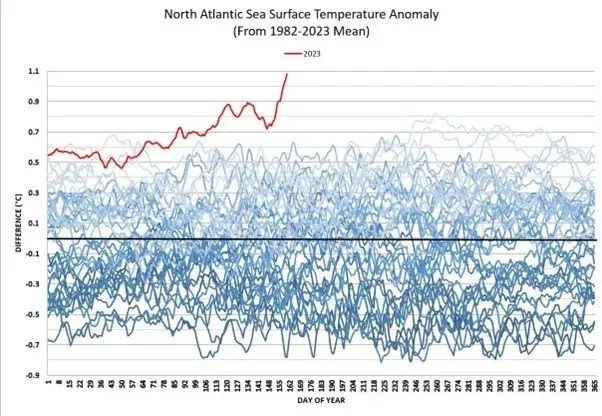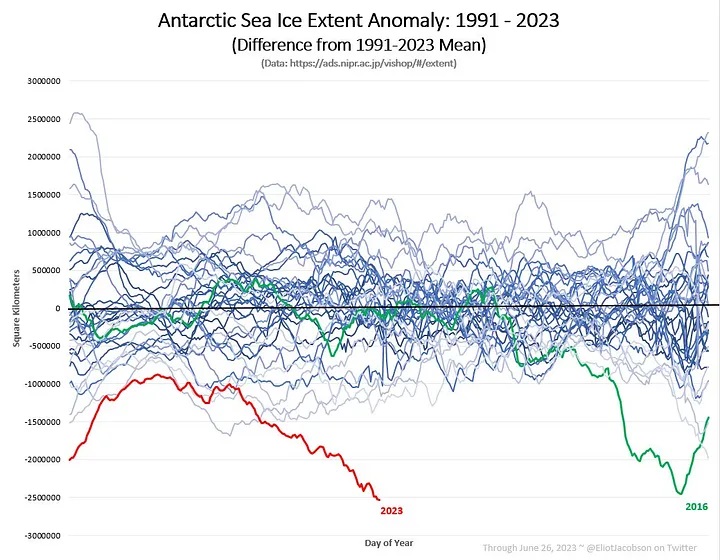This is The Hottest Summer of Your Life…So Far

Summer is here, and it’s a hot one. But not just hot…searing, scorching, sweltering. Across the Northern Hemisphere, billions of people are being slammed with one brutal heat wave after another, and summer has only just begun.
Welcome to the hottest summer of your life…so far.
June of 2023 is going down as the hottest June in recorded history, with the average global temperature surpassing the infamous 1.5°C threshold for several days. Of course, this is just the beginning. El Niño only arrived a few weeks ago, and the world continues to emit greenhouse gases faster than ever.
In Texas, millions of people have been suffering under an historic heatwave for three weeks now. The heatwave is smashing high-temperature records left and right, and demand for power is at an all-time high. Officials fear that if this continues, there could be blackouts during a time when people need AC just to stay alive.
Mexico has had it just as bad. The current heatwave started there in early June, and it’s been spreading North and outward ever since. Multiple high-temperature records have been broken, and Mexico City had its hottest June day ever.
I remember the years when only one or two parts of the world would get a record-breaking heat wave, but now there are so many I can barely keep track. June brought record-highs to dozens of countries around the world.
Early in the month, India had record temperatures in cities all across the country, including Mumbai which had its hottest June day ever. In northern India, it was so bad that 96 people died from heat-aggravated conditions after the power was cut.
China got hit next. The heat broke records all over the country and gave Beijing its hottest June day ever. Normally, this is the time of year when people in China go outside and celebrate things such as the Dragon Boat festival, but this year more people are staying inside and cranking up the AC.
The heat is bringing record-high temperatures to many other countries and territories as well, including the United Kingdom, Puerto Rico, Morocco, Japan, and more. Meanwhile, Canada continues to struggle with its worst wildfire season ever, and the smoke is spreading all over the US.
These heat waves and wildfires are scary enough, but what’s happening in the oceans is even scarier. Sea surface temperatures have been at a record high for three months straight.
Think about that for a moment. Three months of record highs, and it looks like it could go on for several more months. Scientists are baffled.
The worst of it is in the North Atlantic, where an unprecedented heat wave is warming the waters around the UK and Ireland. This kind of temperature spike shouldn’t be possible. As cable news host Chris Hayes said, “Everyone I follow in the climate world is freaking out about this!”

The sudden heat increase is so severe that many people are wondering if we’ve crossed some sort of climate tipping point that we didn’t know about. The heat will likely have a devastating effect on marine life.
Perhaps even more shocking is what’s happening in Antarctica, where sea ice extent is at a record low during a time of year when it should be expanding again. For years, climate deniers have pointed to Antarctica, arguing that global warming can’t be real since Antarctica isn’t melting very much.
Well, look at it now…

According to Eliot Jacobson, a retired professor of mathematics, the odds of this happening purely by chance are 1 in 1,150,000.
Of course, this is not happening by chance. This is happening because we’ve been burning fossil fuels and emitting greenhouse gases as quickly as we want for over a century. When you think about it that way, it’s a wonder that the planet isn’t even hotter.
But the reason it isn’t hotter is because the oceans have been acting as a buffer against climate change, absorbing 89% of excess heat. If not for this, our civilization would have burned to the ground a long time ago.
Every second, the ocean absorbs the heat equivalent of seven Hiroshima nuclear explosions. Every. Single. Second.
When you consider that, it’s not so shocking that the oceans are reaching record high temperatures while sea ice extent hits record lows. Scientists have been warning us about this for decades, and now it’s finally happening.
But this is nothing compared to what’s coming. 2023 will be the hottest year in history, but thanks to El Niño, 2024 will be even hotter. Next year, we’ll see even more heat waves, more wildfires, more ice melt, and more disasters.
Of all the facts I’ve shared with you in this article, the one that amazes me the most is this: Most people still have no idea what’s going on.
Go ahead, ask the average person what they think about the North Atlantic sea surface temperatures or the Antarctic sea ice extent. Watch as they stare at you with a dumb look on their face.
As long as people spend most of their time indoors with air conditioning, they won’t understand or appreciate the magnitude of the climate crisis. They’ll keep telling themselves that it’s not real, or that it’s not so bad, or that we can still adapt.
Eventually, the day will come when we can’t adapt anymore. As I mentioned earlier, a town in Northern India lost power because it got so hot, the grid went down. After that, hospitals were overwhelmed by people dying of heatstroke.
That is just a glimpse of what the future will look like.
So far, the Texas power grid has held up despite record high demand. But someday soon, Texas will have a heat wave so severe that the power grid just won’t be able to handle it. Power lines will literally melt, the grid will go down, and tens of thousands of people will drop dead like something out of a movie about the end of the world.
And it will only get worse from there. What happens when we start seeing temperatures of 50°C or higher on a regular basis? In a Twitter thread last year, Roger Hallam shared some interesting facts:
- You cannot fly a plane at temperatures over 48C
- You die within 6 hours at humid temperatures of 50C
- Major rivers dry up at 40C — (think transport routes)
- Internet centres cannot function over 35C
- Roads, runways, railway tracks and wiring melt at 40C
- Most food crops cannot grow and die at temperatures over 30C
Many people want to believe that we can learn to live with higher temperatures, but there is a hard physical limit to how much we can adapt. Our civilization was not built for temperatures like these, and it won’t survive them.
Already, huge swaths of the planet are on the brink of sustained heat beyond human tolerance, and it’s happening decades earlier than expected. Because of course it is.
So enjoy the summer. Seriously, enjoy it while you can, because in a few years, you’ll look back fondly at how mild the summer of 2023 was.






Member discussion